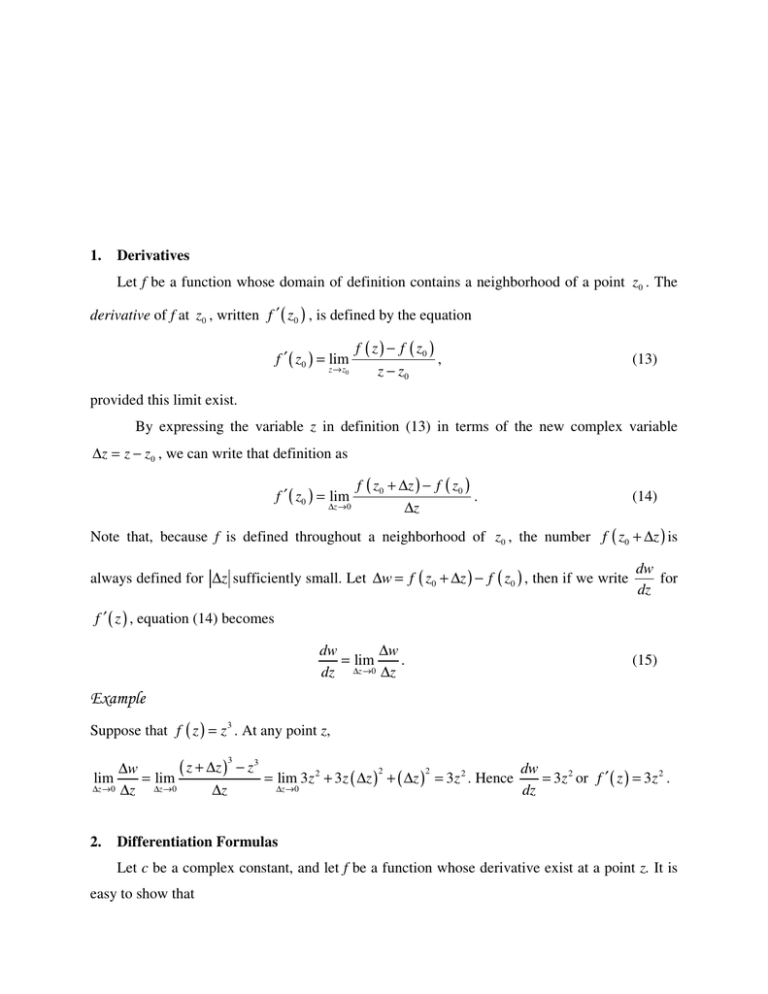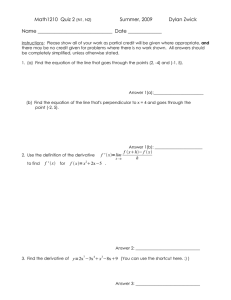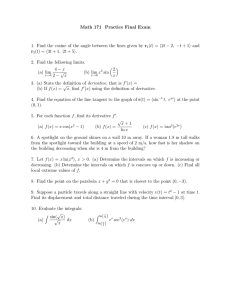( ) f z f z
advertisement

1. Derivatives Let f be a function whose domain of definition contains a neighborhood of a point z0 . The derivative of f at z0 , written f ′ ( z0 ) , is defined by the equation f ′ ( z0 ) = lim z → z0 f ( z ) − f ( z0 ) z − z0 , (13) provided this limit exist. By expressing the variable z in definition (13) in terms of the new complex variable ∆z = z − z0 , we can write that definition as f ′ ( z0 ) = lim ∆z → 0 f ( z0 + ∆z ) − f ( z0 ) . ∆z (14) Note that, because f is defined throughout a neighborhood of z0 , the number f ( z0 + ∆z ) is always defined for ∆z sufficiently small. Let ∆w = f ( z0 + ∆z ) − f ( z0 ) , then if we write dw for dz f ′ ( z ) , equation (14) becomes dw ∆w = lim . dz ∆z →0 ∆z (15) Example Suppose that f ( z ) = z 3 . At any point z, 3 z + ∆z ) − z 3 ( ∆w dw 2 2 lim = lim = lim 3z 2 + 3z ( ∆z ) + ( ∆z ) = 3z 2 . Hence = 3z 2 or f ′ ( z ) = 3 z 2 . ∆z →0 ∆z ∆z →0 ∆ z → 0 ∆z dz 2. Differentiation Formulas Let c be a complex constant, and let f be a function whose derivative exist at a point z. It is easy to show that d c=0, dz d z = 1, dz d cf ( z ) = cf ′ ( z ) . dz (16) Also, if n is a positive integer d n z = nz n−1 dz (17) Theorem If the derivation of two function f and g exist at a point z , then (1) d f ( z ) + g ( z ) = f ′ ( z ) + g ′ ( z ) dz (2) d f ( z ) g ( z ) = f ′ ( z ) g ′ ( z ) dz (3) d f ( z ) f ′ ( z ) g ( z ) − g′ ( z ) f ( z ) , when g ( z ) ≠ 0 . = 2 dz g ( z ) ( g ( z )) Example To find d (2z2 + i) dz the derivative of ( 2z 2 5 + i) . According to the theorem, 5 4 4 = 5 ( 2 z 2 + i ) ( 4 z ) = 20 z ( 2 z 2 + i ) . Exercises 1. Apply definition (15) of derivative to find f ′ ( z ) when a. 1 f ( z) = , z ≠ 0 z b. b. f ( z ) = 3z 2 − 2 z c. c. f ( z ) = z + 1 2 4 2. Apply definition (15) of derivative to find f ′ ( z ) when f ( z ) = z 3 − 4 z at point a. z = z0 b. z = i 3. Use result in Sec. 2 to find f ′ ( z ) when a. f ( z ) = 3z 2 − 4 z + 1 we have b. f ( z ) = (1 − 3 z 3 ) c. f ( z) = 2 z +i 3z − 2 4. If the derivation of two function f and g exist at a point z, proof that d f ( z ) + g ( z ) = f ′ ( z ) + g ′ ( z ) . dz 5. Show that f ′ ( z ) does not exist at any point z when f ( z ) = z .





